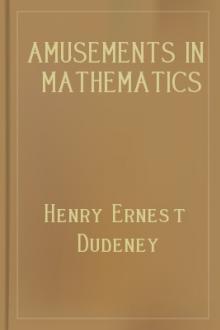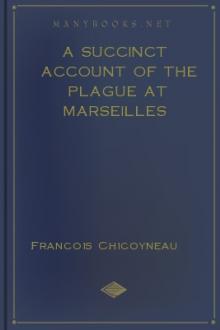Amusements in Mathematics, Henry Ernest Dudeney [books to read to be successful txt] 📗

- Author: Henry Ernest Dudeney
- Performer: 0486204731
Book online «Amusements in Mathematics, Henry Ernest Dudeney [books to read to be successful txt] 📗». Author Henry Ernest Dudeney
121.—HEADS OR TAILS.—solution
Crooks must have lost, and the longer he went on the more he would lose. In two tosses he would be left with three-quarters of his money, in four tosses with nine-sixteenths of his money, in six tosses with twenty-seven sixty-fourths of his money, and so on. The order of the wins and losses makes no difference, so long as their number is in the end equal.
122.—THE SEE-SAW PUZZLE.—solution
The boy's weight must have been about 39.79 lbs. A brick weighed 3 lbs. Therefore 16 bricks weighed 48 lbs. and 11 bricks 33 lbs. Multiply 48 by 33 and take the square root.
123.—A LEGAL DIFFICULTY.—solution
It was clearly the intention of the deceased to give the son twice as much as the mother, or the daughter half as much as the mother. Therefore the most equitable division would be that the mother should take two-sevenths, the son four-sevenths, and the daughter one-seventh.
124.—A QUESTION OF DEFINITION.—solution
There is, of course, no difference in area between a mile square and a square mile. But there may be considerable difference in shape. A mile square can be no other shape than square; the expression describes a surface of a certain specific size and shape. A square mile may be of any shape; the expression names a unit of area, but does not prescribe any particular shape.
125.—THE MINERS' HOLIDAY.—solution
Bill Harris must have spent thirteen shillings and sixpence, which would be three shillings more than the average for the seven men—half a guinea.
126.—SIMPLE MULTIPLICATION.—solution
The number required is 3,529,411,764,705,882, which may be multiplied by 3 and divided by 2, by the simple expedient of removing the 3 from one end of the row to the other. If you want a longer number, you can increase this one to any extent by repeating the sixteen figures in the same order.
127.—SIMPLE DIVISION.—solution
Subtract every number in turn from every other number, and we get 358 (twice), 716, 1,611, 1,253, and 895. Now, we see at a glance that, as 358 equals 2 × 179, the only number that can divide in every case without a remainder will be 179. On trial we find that this is such a divisor. Therefore, 179 is the divisor we want, which always leaves a remainder 164 in the case of the original numbers given.
128.—A PROBLEM IN SQUARES.—solution
The sides of the three boards measure 31 in., 41 in., and 49 in. The common difference of area is exactly five square feet. Three numbers whose squares are in A.P., with a common difference of 7, are 113/120, 337/120, 463/120; and with a common difference of 13 are 80929/19380, 106921/19380, and 127729/19380. In the case of whole square numbers the common difference will always be divisible by 24, so it is obvious that our squares must be fractional. Readers should now try to solve the case where the common difference is 23. It is rather a hard nut.
129.—THE BATTLE OF HASTINGS.—solution
Any number (not itself a square number) may be multiplied by a square that will give a product 1 less than another square. The given number must not itself be a square, because a square multiplied by a square produces a square, and no square plus 1 can be a square. My remarks throughout must be understood to apply to whole numbers, because fractional soldiers are not of much use in war.
Now, of all the numbers from 2 to 99 inclusive, 61 happens to be the most awkward one to work, and the lowest possible answer to our puzzle is that Harold's army consisted of 3,119,882,982,860,264,400 men. That is, there would be 51,145,622,669,840,400 men (the square of 226,153,980) in each of the sixty-one squares. Add one man (Harold), and they could then form one large square with 1,766,319,049 men on every side. The general problem, of which this is a particular case, is known as the "Pellian Equation"—apparently because Pell neither first propounded the question nor first solved it! It was issued as a challenge by Fermat to the English mathematicians of his day. It is readily solved by the use of continued fractions.
Next to 61, the most difficult number under 100 is 97, where 97 × 6,377,3522 + 1 = a square.
The reason why I assumed that there must be something wrong with the figures in the chronicle is that we can confidently say that Harold's army did not contain over three trillion men! If this army (not to mention the Normans) had had the whole surface of the earth (sea included) on which to encamp, each man would have had slightly more than a quarter of a square inch of space in which to move about! Put another way: Allowing one square foot of standing-room per man, each small square would have required all the space allowed by a globe three times the diameter of the earth.
130.—THE SCULPTOR'S PROBLEM.—solution
A little thought will make it clear that the answer must be fractional, and that in one case the numerator will be greater and in the other case less than the denominator. As a matter of fact, the height of the larger cube must be 8/7 ft., and of the smaller 3/7 ft., if we are to have the answer in the smallest possible figures. Here the lineal measurement is 11/7 ft.—that is, 14/7 ft. What are the cubic contents of the two cubes? First 8/7 × 3/7 × 8/7 = 512/343, and secondly 3/7 × 3/7 × 3/7 = 27/343. Add these together and the result is 539/343, which reduces to 11/7 or 14/7 ft. We thus see that the answers in cubic feet and lineal feet are precisely the same.
The germ of the idea is to be found in the works of Diophantus of Alexandria, who wrote about the beginning of the fourth century. These fractional numbers appear in triads, and are obtained from three generators, a, b, c, where a is the largest and c the smallest.
Then ab+c2=denominator, and a2-c2, b2-c2, and a2-b2 will be the three numerators. Thus, using the generators 3, 2, 1, we get 8/7, 3/7, 5/7 and we can pair the first and second, as in the above solution, or the first and third for a second solution. The denominator must always be a prime number of the form 6n+1, or composed of such primes. Thus you can have 13, 19, etc., as denominators, but not 25, 55, 187, etc.
When the principle is understood there is no difficulty in writing down the dimensions of as many sets of cubes as the most exacting collector may require. If the reader would like one, for example, with plenty of nines, perhaps the following would satisfy him: 99999999/99990001 and 19999/99990001.
131.—THE SPANISH MISER.—solution
There must have been 386 doubloons in one box, 8,450 in another, and 16,514 in the third, because 386 is the smallest number that can occur. If I had asked for the smallest aggregate number of coins, the answer would have been 482, 3,362, and 6,242. It will be found in either case that if the contents of any two of the three boxes be combined, they form a square number of coins. It is a curious coincidence (nothing more, for it will not always happen) that in the first solution the digits of the three numbers add to 17 in every case, and in the second solution to 14. It should be noted that the middle one of the three numbers will always be half a square.
132.—THE NINE TREASURE BOXES.—solution
Here is the answer that fulfils the conditions:—
Each of these is a square number, the roots, taken in alphabetical order, being 2, 58, 82, 46, 74, 94, 97, 113, and 127, while the required difference between A and B, B and C, D and E. etc., is in every case 3,360.
133.—THE FIVE BRIGANDS.—solution
The sum of 200 doubloons might have been held by the five brigands in any one of 6,627 different ways. Alfonso may have held any number from 1 to 11. If he held 1 doubloon, there are 1,005 different ways of distributing the remainder; if he held 2, there are 985 ways; if 3, there are 977 ways; if 4, there are 903 ways; if 5 doubloons, 832 ways; if 6 doubloons, 704 ways; if 7 doubloons, 570 ways; if 8 doubloons, 388 ways; if 9 doubloons, 200 ways; if 10 doubloons, 60 ways; and if Alfonso held 11 doubloons, the remainder could be distributed in 3 different ways. More than 11 doubloons he could not possibly have had. It will scarcely be expected that I shall give all these 6,627 ways at length. What I propose to do is to enable the reader, if he should feel so disposed, to write out all the answers where Alfonso has one and the same amount. Let us take the cases where Alfonso has 6 doubloons, and see how we may obtain all the 704 different ways indicated above. Here are two tables that will serve as keys to all these answers:—
In the first table we may substitute for n any whole number from 1 to 12 inclusive, and m may be nought or any whole number from 1 to (31 + n) inclusive. In the second table n may have the value of any whole number from 13 to 23 inclusive, and m may be nought or any whole number from 1 to (93 - 4n) inclusive. The first table thus gives (32 + n) answers for every value of n; and the second table gives (94 - 4n) answers for every value of n. The former, therefore, produces 462 and the latter 242 answers, which together make 704, as already stated.
Let us take Table I., and say n = 5 and m = 2; also in Table II. take n = 13 and m = 0. Then we at once get these two answers:—
doubloons
doubloons.
These will be found to work correctly. All the rest of the 704 answers, where Alfonso always holds six doubloons, may be obtained in this way from the two tables by substituting the different numbers for the letters m and n.
Put in another way, for every holding of Alfonso the number of answers is the sum of two arithmetical progressions, the common difference in one case being 1 and in the other -4. Thus in the case where Alfonso holds 6 doubloons one progression is 33 + 34 + 35 + 36 + ... + 43 + 44, and the other 42 + 38 + 34 + 30 + ... + 6 + 2. The sum of the first series is 462, and of the second 242—results which again agree with the figures already given. The problem may be said to consist in finding the first and last terms of these progressions. I should remark that where Alfonso holds 9, 10, or 11 there is only one progression, of the second form.
134.—THE BANKER'S PUZZLE.—solution
In order that a number of sixpences may not be divisible into a number of equal piles, it is necessary that the number should be a prime. If the banker can bring about





Comments (0)